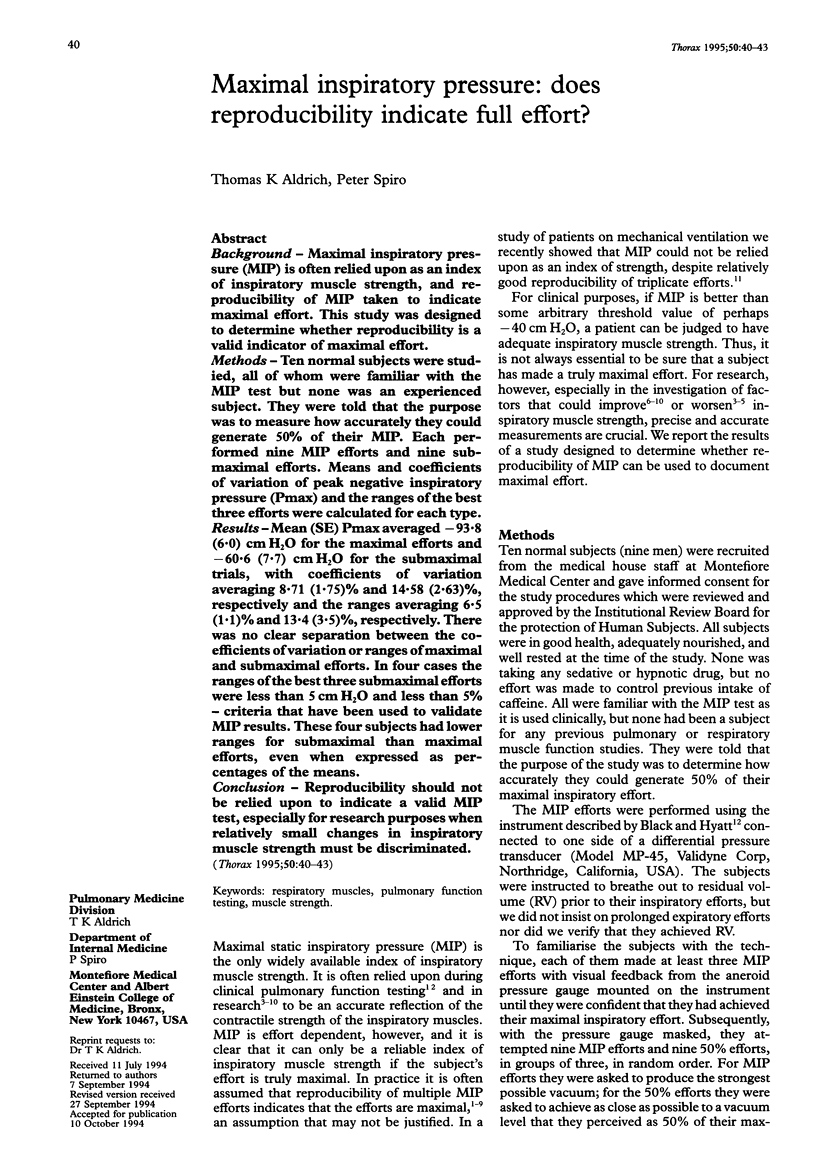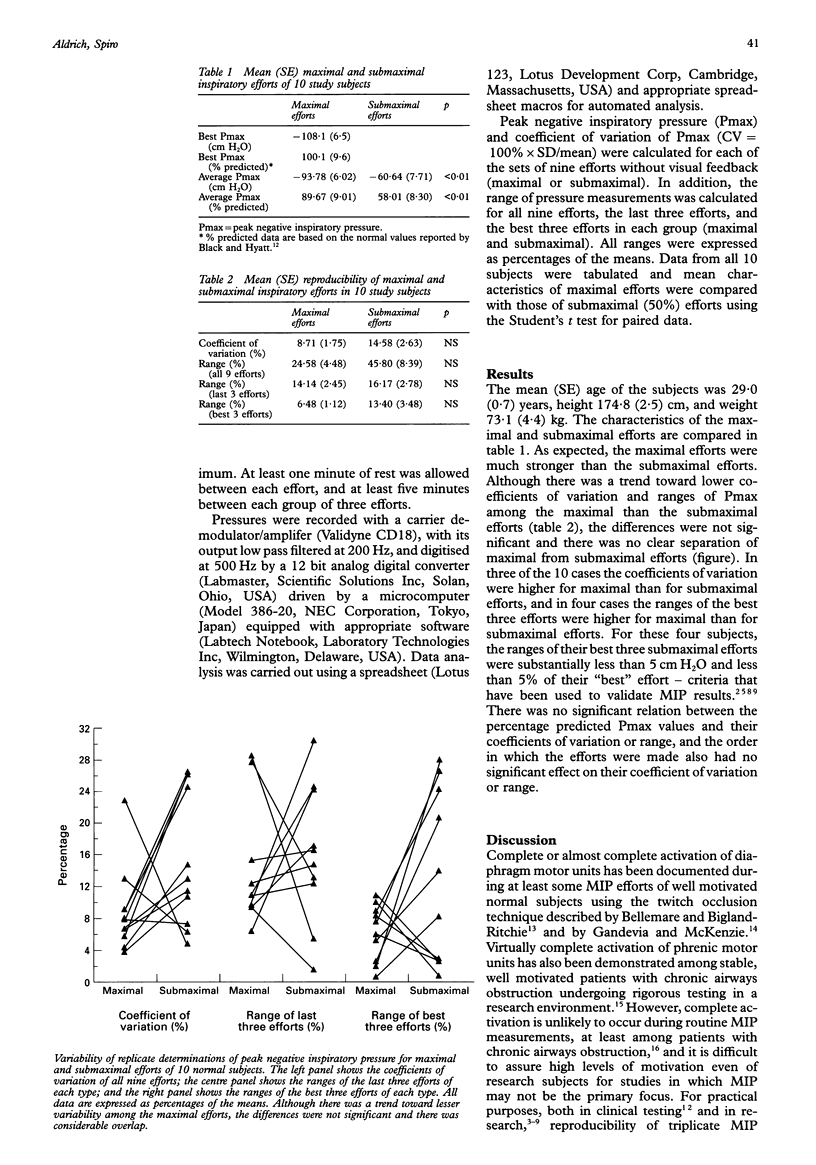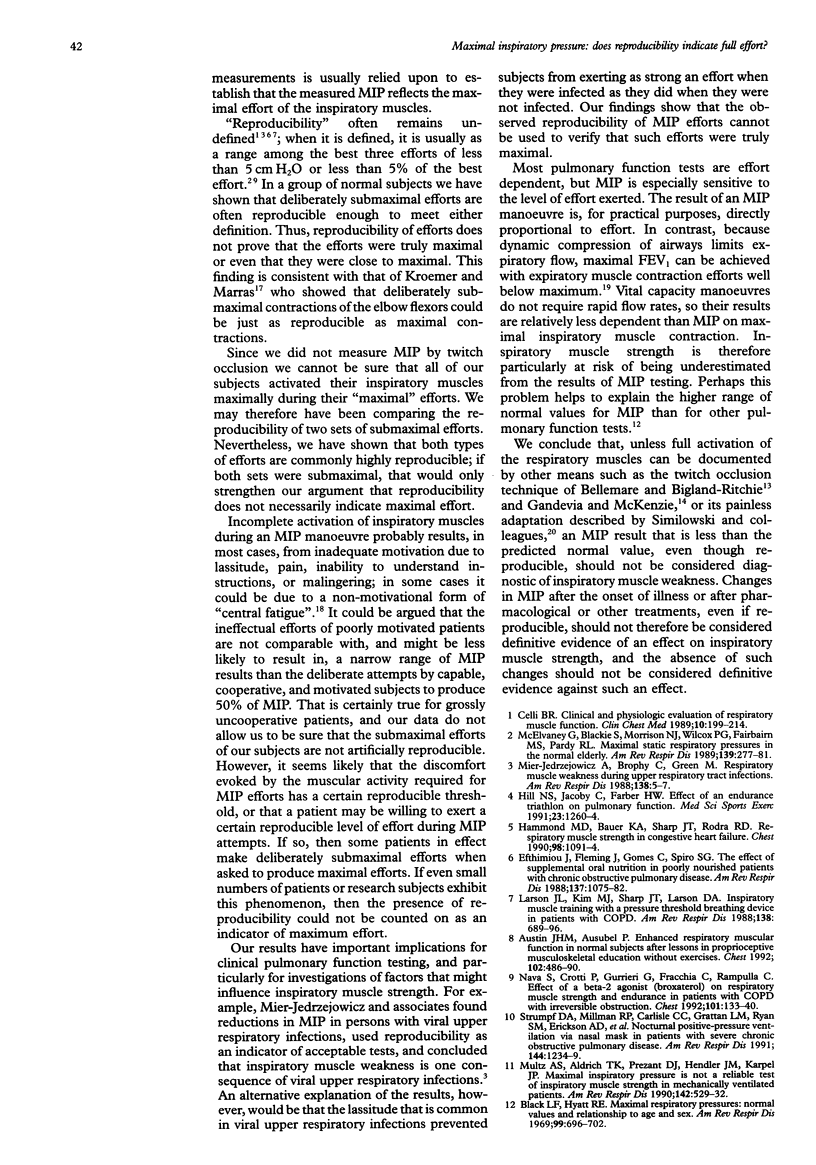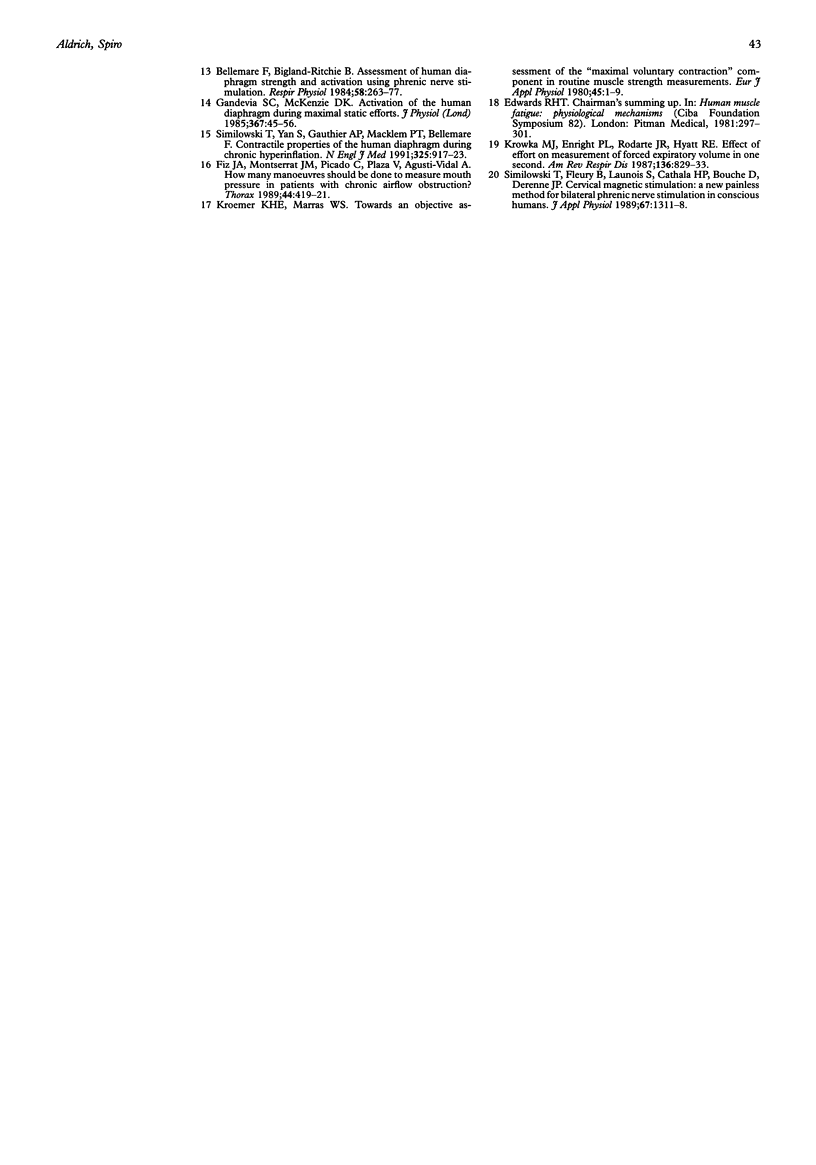Abstract
BACKGROUND--Maximal inspiratory pressure (MIP) is often relied upon as an index of inspiratory muscle strength, and reproducibility of MIP taken to indicate maximal effort. This study was designed to determine whether reproducibility is a valid indicator of maximal effort. METHODS--Ten normal subjects were studied, all of whom were familiar with the MIP test but none was an experienced subject. They were told that the purpose was to measure how accurately they could generate 50% of their MIP. Each performed nine MIP efforts and nine submaximal efforts. Means and coefficients of variation of peak negative inspiratory pressure (Pmax) and the ranges of the best three efforts were calculated for each type. RESULTS--Mean (SE) Pmax averaged-93.8 (6.0) cm H2O for the maximal efforts and -60.6 (7.7) cm H2O for the submaximal trials, with coefficients of variation averaging 8.71 (1.75)% and 14.58 (2.63)%, respectively and the ranges averaging 6.5 (1.1)% and 13.4 (3.5)%, respectively. There was no clear separation between the coefficients of variation or ranges of maximal and submaximal efforts. In four cases the ranges of the best three submaximal efforts were less than 5 cm H2O and less than 5% -criteria that have been used to validate MIP results. These four subjects had lower ranges for submaximal than maximal efforts, even when expressed as percentages of the means. CONCLUSION--Reproducibility should not be relied upon to indicate a valid MIP test, especially for research purposes when relatively small changes in inspiratory muscle strength must be discriminated.
Full text
PDF



Selected References
These references are in PubMed. This may not be the complete list of references from this article.
- Austin J. H., Ausubel P. Enhanced respiratory muscular function in normal adults after lessons in proprioceptive musculoskeletal education without exercises. Chest. 1992 Aug;102(2):486–490. doi: 10.1378/chest.102.2.486. [DOI] [PubMed] [Google Scholar]
- Bellemare F., Bigland-Ritchie B. Assessment of human diaphragm strength and activation using phrenic nerve stimulation. Respir Physiol. 1984 Dec;58(3):263–277. doi: 10.1016/0034-5687(84)90003-3. [DOI] [PubMed] [Google Scholar]
- Black L. F., Hyatt R. E. Maximal respiratory pressures: normal values and relationship to age and sex. Am Rev Respir Dis. 1969 May;99(5):696–702. doi: 10.1164/arrd.1969.99.5.696. [DOI] [PubMed] [Google Scholar]
- Celli B. R. Clinical and physiologic evaluation of respiratory muscle function. Clin Chest Med. 1989 Jun;10(2):199–214. [PubMed] [Google Scholar]
- Efthimiou J., Fleming J., Gomes C., Spiro S. G. The effect of supplementary oral nutrition in poorly nourished patients with chronic obstructive pulmonary disease. Am Rev Respir Dis. 1988 May;137(5):1075–1082. doi: 10.1164/ajrccm/137.5.1075. [DOI] [PubMed] [Google Scholar]
- Fiz J. A., Montserrat J. M., Picado C., Plaza V., Agusti-Vidal A. How many manoeuvres should be done to measure maximal inspiratory mouth pressure in patients with chronic airflow obstruction? Thorax. 1989 May;44(5):419–421. doi: 10.1136/thx.44.5.419. [DOI] [PMC free article] [PubMed] [Google Scholar]
- Gandevia S. C., McKenzie D. K. Activation of the human diaphragm during maximal static efforts. J Physiol. 1985 Oct;367:45–56. doi: 10.1113/jphysiol.1985.sp015813. [DOI] [PMC free article] [PubMed] [Google Scholar]
- Hammond M. D., Bauer K. A., Sharp J. T., Rocha R. D. Respiratory muscle strength in congestive heart failure. Chest. 1990 Nov;98(5):1091–1094. doi: 10.1378/chest.98.5.1091. [DOI] [PubMed] [Google Scholar]
- Hill N. S., Jacoby C., Farber H. W. Effect of an endurance triathlon on pulmonary function. Med Sci Sports Exerc. 1991 Nov;23(11):1260–1264. [PubMed] [Google Scholar]
- Kroemer K. H., Marras W. S. Towards an objective assessment of the "maximal voluntary contraction" component in routine muscle strength measurements. Eur J Appl Physiol Occup Physiol. 1980;45(1):1–9. doi: 10.1007/BF00421195. [DOI] [PubMed] [Google Scholar]
- Krowka M. J., Enright P. L., Rodarte J. R., Hyatt R. E. Effect of effort on measurement of forced expiratory volume in one second. Am Rev Respir Dis. 1987 Oct;136(4):829–833. doi: 10.1164/ajrccm/136.4.829. [DOI] [PubMed] [Google Scholar]
- Larson J. L., Kim M. J., Sharp J. T., Larson D. A. Inspiratory muscle training with a pressure threshold breathing device in patients with chronic obstructive pulmonary disease. Am Rev Respir Dis. 1988 Sep;138(3):689–696. doi: 10.1164/ajrccm/138.3.689. [DOI] [PubMed] [Google Scholar]
- McElvaney G., Blackie S., Morrison N. J., Wilcox P. G., Fairbarn M. S., Pardy R. L. Maximal static respiratory pressures in the normal elderly. Am Rev Respir Dis. 1989 Jan;139(1):277–281. doi: 10.1164/ajrccm/139.1.277. [DOI] [PubMed] [Google Scholar]
- Mier-Jedrzejowicz A., Brophy C., Green M. Respiratory muscle weakness during upper respiratory tract infections. Am Rev Respir Dis. 1988 Jul;138(1):5–7. doi: 10.1164/ajrccm/138.1.5. [DOI] [PubMed] [Google Scholar]
- Multz A. S., Aldrich T. K., Prezant D. J., Karpel J. P., Hendler J. M. Maximal inspiratory pressure is not a reliable test of inspiratory muscle strength in mechanically ventilated patients. Am Rev Respir Dis. 1990 Sep;142(3):529–532. doi: 10.1164/ajrccm/142.3.529. [DOI] [PubMed] [Google Scholar]
- Nava S., Crotti P., Gurrieri G., Fracchia C., Rampulla C. Effect of a beta 2-agonist (broxaterol) on respiratory muscle strength and endurance in patients with COPD with irreversible airway obstruction. Chest. 1992 Jan;101(1):133–140. doi: 10.1378/chest.101.1.133. [DOI] [PubMed] [Google Scholar]
- Similowski T., Fleury B., Launois S., Cathala H. P., Bouche P., Derenne J. P. Cervical magnetic stimulation: a new painless method for bilateral phrenic nerve stimulation in conscious humans. J Appl Physiol (1985) 1989 Oct;67(4):1311–1318. doi: 10.1152/jappl.1989.67.4.1311. [DOI] [PubMed] [Google Scholar]
- Similowski T., Yan S., Gauthier A. P., Macklem P. T., Bellemare F. Contractile properties of the human diaphragm during chronic hyperinflation. N Engl J Med. 1991 Sep 26;325(13):917–923. doi: 10.1056/NEJM199109263251304. [DOI] [PubMed] [Google Scholar]
- Strumpf D. A., Millman R. P., Carlisle C. C., Grattan L. M., Ryan S. M., Erickson A. D., Hill N. S. Nocturnal positive-pressure ventilation via nasal mask in patients with severe chronic obstructive pulmonary disease. Am Rev Respir Dis. 1991 Dec;144(6):1234–1239. doi: 10.1164/ajrccm/144.6.1234. [DOI] [PubMed] [Google Scholar]


